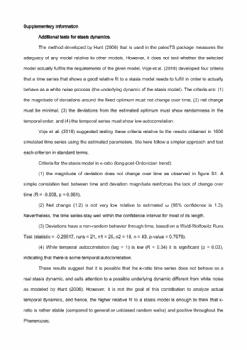Search
Now showing items 1-10 of 10
TriloMorph: a dynamic and collaborative database for morphogeometric information of trilobitesTriloMorph: una base de datos dinámica y colaborativa de información morfogeométrica de los trilobites
(2023-06-12)
Modern morphometric-based approaches provide valuable metrics to quantify and understand macroevolutionary and macroecological patterns and processes. However, very few large scale morphological datasets are currently ...
Results of genetic and demographic analyses including probability of capturing the deepest coalescent event (Prob.), number of haplotypes (K), haplotype diversity (h), nucleotide diversity (π), Fu’s Fs (Fs), Tajima’s D (DT), Probability of DT ≠ 0 [Prob. (|DT|) > 0], probability of DT ≠ 0 based on coalescent simulations (P), Ramos-Onsins & Rozas’ (R2), probability of R2 based on coalescent simulations (P), maximum pairwise differences between any two sequences (k).Resultados de los análisis genéticos y demográficos, incluyendo la probabilidad de capturar el evento coalescente más profundo (Prob.), número de haplotipos (K), diversidad de haplotipos (h), diversidad de nucleótidos (π), Fs de Fu (Fs), D de Tajima (DT), Probabilidad de DT ≠ 0 [Prob. (|DT|) > 0], probabilidad de DT ≠ 0 basada en simulaciones coalescentes (P), Ramos-Onsins & Rozas' (R2), probabilidad de R2 basada en simulaciones coalescentes (P), diferencias máximas por pares entre dos secuencias cualesquiera (k).
(Plos One, 2015-06-25)
The sum of squared deviations (SSD) is also given.
Results of genetic and demographic analyses including probability of capturing the deepest coalescent event (Prob.), number of haplotypes (K), haplotype diversity (h), ...
Carbonate collapse and the Late Paleozoic Ice Age marine biodiversity crisisEl colapso de los carbonatos y la crisis biótica de la edad de hielo del Paleozoico tardío
(2019)
The Late Paleozoic ice age was characterized by persistently low
diversity of marine invertebrates following a second-order mass
extinction. Here, we use a data set of North American (paleotropical)
fossil occurrences ...
Early-Middle Ordovician graptolites from the Argentine Puna: quantitative paleobiogeographic analysis based on a systematic revisionGraptolitos del Ordovícico Temprano-Medio de la Puna, Argentina: Análisis Paleobiogeográfico Cuantitativo basado en una revisión sistemática
(2020-07)
The updated taxonomic revision of the Early–Middle Ordovician graptolites from the eastern Argentine Puna allows describing Sigmagraptus praecursor, Baltograptus extremus, B. geometricus, B. vacillans, Cymatograptus
pr ...
A novel distance that reduces information loss in continuous characters with few observations
(2023)
The calculation of pairwise distances is a fundamental step in many statistical analyses in biology and paleontology. The most commonly used distances work with a single observation per object and character, but there are ...
Conjunto de datos de retención de semillas
(Willey, 2019-03-02)
Not gone with the wind: Vegetation complexity increases seed retention during windy periods in the Argentine Semiarid Chaco.
Relative oversampling of carbonate rocks in the North American marine fossil record
(Cambridge University Press, 2023)
Paleontologists have long stressed the need to know how sampling the fossil record might influence our knowledge of the evolution of life. Here, we combine fossil occurrences of North American marine invertebrates from the ...
Grain size, chemistry and mineralogy of dust from Mar Chiquita saline lake
(2022)
This dataset includes measurements of mineralogy using XRPD and SEM/EDS, grain size distribution using laser-diffraction, bulk chemical composition using FUS-ICP and water-soluble composition using ICP-MS. Samples consisted ...
Especies de Flebotomos colectados y datos meteorológicos asociados
(2023)
Colectas de especies de Flebótomos y datos meteorológicos asociados a las fechas de muestreo que corresponden entre 2011 y 2014 con el objetivo de estudiar los efectos de las variables ambientales sobre la actividad de las ...
Registros paleobiogeográficos de graptoloideos Floianos (Ordovícico Temprano)
(2019)
Registros de gaptolitos ordovícicos de la secciones de Muñayoc y Río Santa Rosa, provincia de Jujuy, y de otras regiones del mundo con el fin de realizar un análisis paleobiogeográfico.




